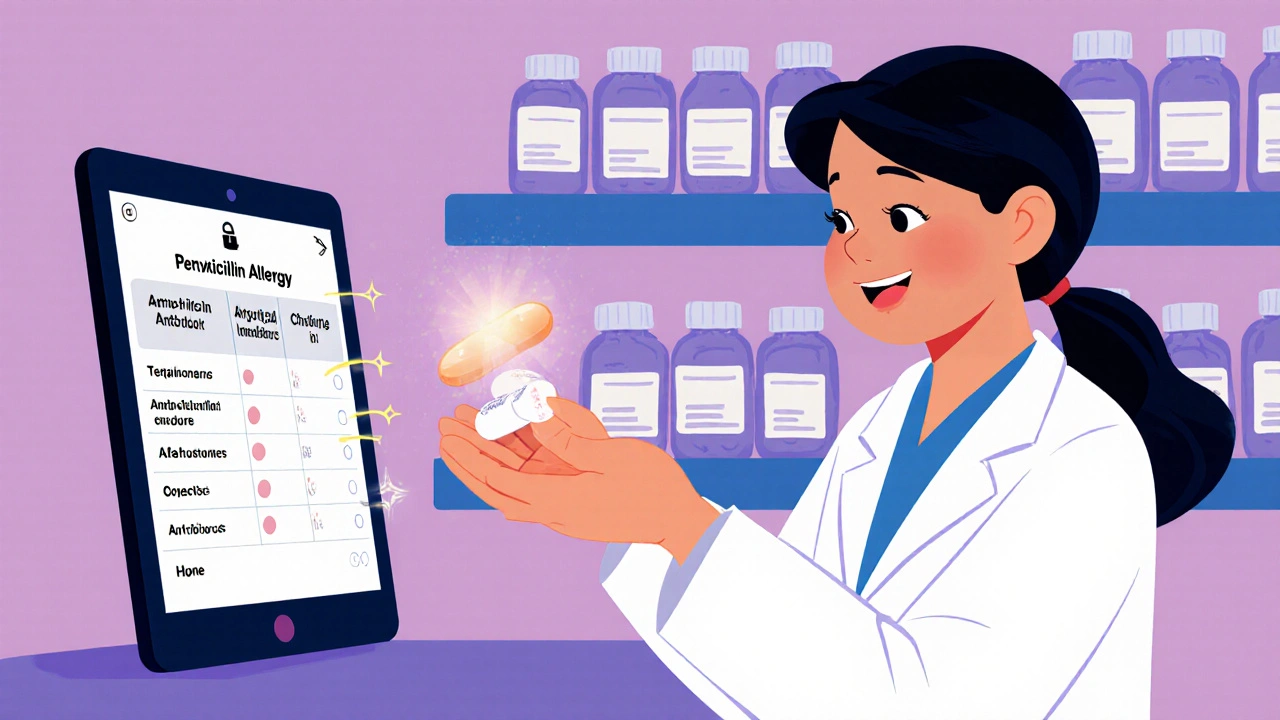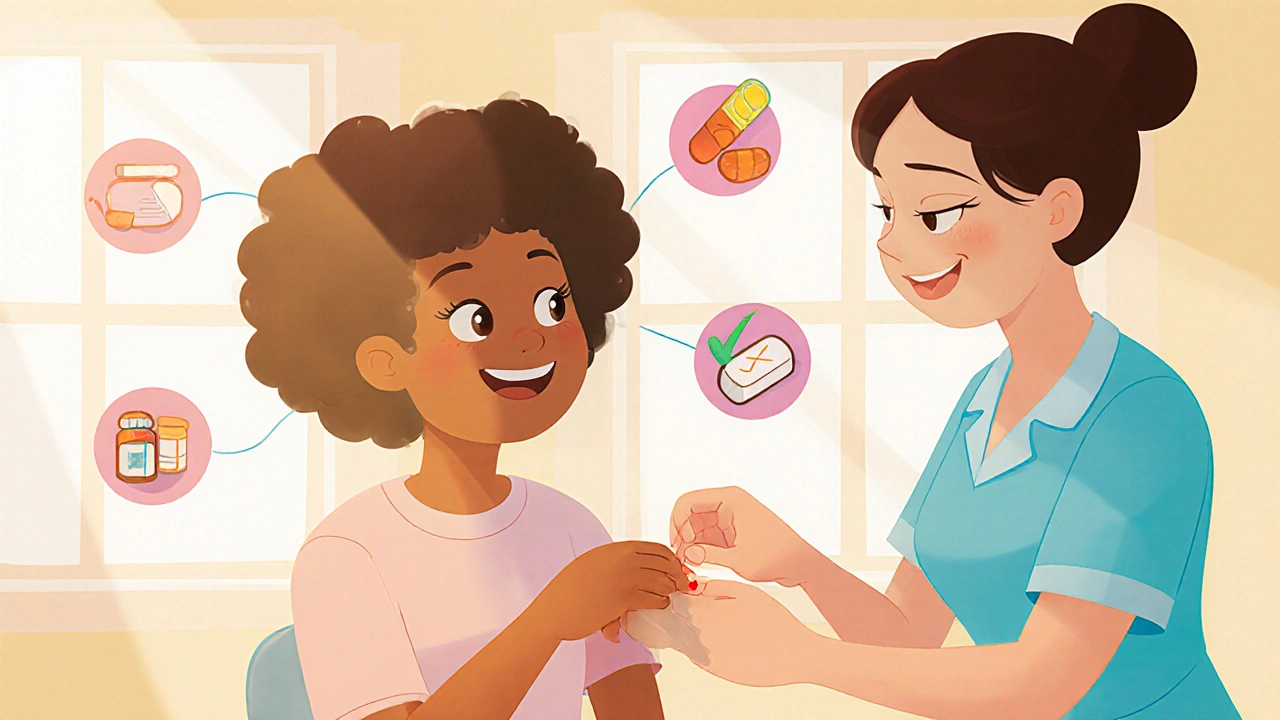Penicillin Allergy Risk Assessment Tool
How likely is your penicillin allergy label to be incorrect?
Only 5-10% of people with a penicillin allergy label actually have a true allergy. This tool helps you assess your risk based on your reaction history.
Answer the questions above to see your assessment.
More than 10% of people in the U.S. say they’re allergic to penicillin. But here’s the truth: 90% to 95% of them aren’t. That’s not a typo. Most people who think they’re allergic to penicillin can safely take it - and should. The problem? Too many are stuck with the label, and it’s costing them more than just peace of mind.
Why the Penicillin Allergy Label Is Dangerous
If you’ve been told you’re allergic to penicillin, doctors avoid giving you penicillin or any related antibiotic - like amoxicillin, ampicillin, or cefalexin. That sounds safe. But it’s not. Instead, you’re often given stronger, broader antibiotics like vancomycin, clindamycin, or fluoroquinolones. These drugs are more expensive, less targeted, and far riskier.Studies show patients with a penicillin allergy label have a 69% higher chance of getting a Clostridioides difficile infection - a severe, sometimes deadly gut infection caused by antibiotic overuse. They’re also 50% more likely to develop surgical site infections and 30% more likely to have treatment fail entirely. That’s not because penicillin is dangerous. It’s because the alternatives are.
Costs rise too. A single course of amoxicillin costs about $34.50. The alternatives? Around $95.20. Multiply that by millions of patients, and you’re talking about billions in wasted healthcare spending every year.
How Penicillin Allergy Testing Works
Penicillin allergy testing isn’t a single blood test. It’s a two-step process designed to find out if your body truly reacts to penicillin with IgE antibodies - the kind that cause immediate, life-threatening reactions like anaphylaxis.First, you get a skin test. A tiny amount of penicillin reagent is placed on your skin, then gently pricked. If nothing happens, a small injection is made under the skin. This step uses two key reagents: one for the major penicillin determinant (Pre-Pen) and another for the minor ones. In the U.S., Pre-Pen is the only FDA-approved skin test reagent - it’s been around since 1970.
If the skin test is negative, you move to the second step: an oral challenge. You swallow a small dose of amoxicillin - usually 250 mg - and are monitored for an hour. If you don’t react, you’re cleared. No more allergy label.
The whole process takes about an hour. No hospital stay. No overnight observation. And if done right, it’s more than 95% accurate at ruling out true IgE-mediated allergy. That means if you test negative, your risk of anaphylaxis drops to the same level as someone who never claimed to be allergic.
Who Should Get Tested
Not everyone needs testing. But if you’ve ever had any reaction after taking penicillin - even a mild rash - you should be evaluated.Low-risk history? That’s a rash that showed up more than 72 hours after taking the drug, or a vague symptom like headache or stomach upset. These patients can often skip skin testing and go straight to an oral challenge under supervision.
Moderate-risk? Hives, itching, or swelling within 1 to 6 hours after taking penicillin? You need skin testing first, then an oral challenge.
High-risk? Anaphylaxis, trouble breathing, or a drop in blood pressure? You need to see an allergist. But even here, testing can help - if the reaction happened more than 10 years ago, your risk of true allergy has dropped dramatically.
And here’s the exception: If you had a severe delayed reaction like Stevens-Johnson syndrome, DRESS, or toxic epidermal necrolysis - don’t test. Those are T-cell reactions, not IgE. You must avoid all beta-lactam antibiotics forever.

Why Testing Isn’t More Common
You’d think this would be standard everywhere. But it’s not.In 2016, only 15% of U.S. hospitals offered penicillin allergy testing. By 2022, that number jumped to 39% - still far from universal. The biggest barrier? Access to allergists. Most hospitals don’t have one on staff. But that’s changing.
Pharmacists, nurses, and infectious disease doctors are now being trained to run these tests. In academic medical centers, pharmacists handle nearly half of all penicillin allergy assessments - up from just 12% in 2017. That’s a game-changer.
Even better, a new all-in-one test kit is under FDA review. It includes the major and minor determinants plus amoxicillin. Early results from a 455-patient study showed a 98% negative predictive value. If approved, it could mean no oral challenge needed - just one skin test and you’re done.
What Happens After a Negative Test
Testing isn’t just about finding out you’re not allergic. It’s about changing your medical record.If you pass the test, your allergy label must be removed. Not just noted as “resolved.” Not just scribbled in a chart. Officially deleted. In the electronic health record. By a nurse or pharmacist. With documentation: “Tolerated penicillin class antibiotic - allergy removed.”
Without this step, the label sticks. And you’re still treated as allergic. That’s why follow-up is critical. Hospitals that track this see 30% to 50% increases in appropriate penicillin use after testing programs launch.

The Bigger Picture: Antibiotic Stewardship
Penicillin allergy testing isn’t just about one drug. It’s part of a larger movement called antibiotic stewardship - using antibiotics wisely to protect public health.Every time we avoid penicillin unnecessarily, we push bacteria toward resistance. We increase C. diff rates. We raise costs. We risk treatment failure.
The CDC estimates that by 2027, 85% of U.S. hospitals will have integrated penicillin testing into routine care. That could prevent 50,000 to 70,000 C. diff cases every year. That’s not a guess. It’s a projection based on real data from hospitals that have already made the change.
And it’s not just hospitals. The CDC updated its STI treatment guidelines in 2023 to say: 97% of patients who say they’re allergic to penicillin can safely get it for syphilis - if they’re tested first. That’s huge. Syphilis is rising. Penicillin is the only cure. If we keep avoiding it, we’re making the epidemic worse.
What You Can Do
If you’ve been told you’re allergic to penicillin:- Ask your doctor: “Was this confirmed with testing?”
- If no - ask if you can be referred for penicillin allergy testing.
- If you’ve never had a severe reaction - testing is likely safe and worth it.
- Bring your old records. Even a vague note like “rash after penicillin” matters.
- Don’t assume the label is permanent. Allergies fade over time.
And if you’re a healthcare provider: Start a testing program. Train your pharmacists. Talk to your allergist. It’s not just good medicine - it’s cost-effective, life-saving medicine.
Can I outgrow a penicillin allergy?
Yes. Most people who had a penicillin allergy as a child or young adult lose their sensitivity over time. Studies show that 8 out of 10 people who had a reaction more than 10 years ago can safely take penicillin today. That’s why testing is recommended even if your allergy was diagnosed decades ago.
Is penicillin skin testing painful?
It’s not painful - it’s like a tiny pinprick. The intradermal test feels like a small bee sting, but it’s brief. Most people report no discomfort at all. The oral challenge involves swallowing a pill, which is completely painless. Any reaction, if it happens, is usually mild and easily treated.
Can I be tested if I’m pregnant?
Yes. Penicillin is the preferred antibiotic for treating infections during pregnancy - including syphilis, group B strep, and urinary tract infections. Skin testing and oral challenges are considered safe during pregnancy. In fact, testing can help avoid riskier alternatives that might harm the baby.
What if I had a reaction as a child but can’t remember the details?
That’s common. Many people are told they’re allergic based on a vague family history or a mild rash from childhood. If you can’t recall specifics - like whether it was hives, swelling, or just a rash - you’re still a good candidate for testing. Low-risk histories are often cleared with an oral challenge alone.
Will my insurance cover penicillin allergy testing?
Most insurance plans in the U.S. cover penicillin allergy testing when ordered by a doctor, especially if it’s done in a hospital or clinic setting. The cost is usually under $200, and it’s often less than the price of one alternative antibiotic. Many hospitals absorb the cost as part of their antibiotic stewardship program.
Can I be tested if I’ve never taken penicillin but have a family history?
Family history alone doesn’t mean you’re allergic. Penicillin allergy isn’t inherited like eye color. If you’ve never had a reaction, you don’t need testing - unless you’re about to need penicillin for surgery or an infection. In those cases, testing can be done safely even without a prior reaction history.

Comments
Shawna B
I never knew most people aren't actually allergic. Just got my label at 8 and never questioned it.
On November 16, 2025 AT 07:40
Krys Freeman
Typical US healthcare waste. People panic over a rash and then get pumped full of drugs that cost 3x more and make them sicker. Fix the system, not the label.
On November 17, 2025 AT 10:40
Jerry Ray
So you're telling me the whole medical industry is built on a myth? That's rich. Next you'll say vaccines cause autism or that the moon landing was faked. I've seen too many patients crash after penicillin to believe this.
On November 18, 2025 AT 21:28
David Ross
Let me be perfectly clear: this is not a "myth." It's a systemic failure of medical education, documentation, and liability-avoidance culture. The fact that 95% of self-reported penicillin allergies are false is not a coincidence-it's a consequence of lazy triage, inadequate follow-up, and the medical establishment’s refusal to admit error. The CDC’s projection of 50,000–70,000 prevented C. diff cases annually? That’s not optimistic-it’s conservative. And yet, hospitals still won’t fund testing programs. Why? Because it’s cheaper to keep prescribing vancomycin. And because no one wants to be sued if someone *does* react. The real danger isn’t penicillin-it’s the institutional cowardice that keeps people locked into a false label.
On November 19, 2025 AT 06:36
Sophia Lyateva
wait so the gubmint and big pharma are making us think we're allergic so they can sell us more expensive antibiotics?? and then they say its "stewardship"?? this smells like a vaccine scam but with pills
On November 20, 2025 AT 03:07
AARON HERNANDEZ ZAVALA
I had a rash when I was 12 after amoxicillin. Got labeled allergic. Never thought to question it. Last year I needed it for a sinus infection and my doctor pushed me to get tested. Turned out I was fine. Best medical decision I ever made. Why didn't anyone tell me this before?
On November 21, 2025 AT 15:11
Lyn James
Let’s be honest-this isn’t about science. It’s about accountability. We live in a culture that rewards avoidance over responsibility. Parents don’t want to admit their child had a harmless rash. Doctors don’t want to spend the time verifying. Hospitals don’t want to risk liability. And so we’ve created a national epidemic of misdiagnosis, where millions are being denied the safest, cheapest, most effective antibiotic in history because we’d rather cling to a label than face the uncomfortable truth: we were wrong. And now, we’re paying for it-in suffering, in cost, in resistance. This isn’t just a medical issue. It’s a moral one. We’ve chosen convenience over care. And the cost? It’s written in every C. diff case, every failed surgery, every unnecessary death that could’ve been avoided with a simple skin prick and an honest conversation.
On November 23, 2025 AT 06:47
Craig Ballantyne
The data is compelling, and the logistical shift toward pharmacist-led assessment is both pragmatic and scalable. However, the transition from institutional inertia to standardized protocol requires not only training but also EHR integration and regulatory alignment. The emerging single-kits with predictive value exceeding 98% represent a significant step toward de-risking the process, though real-world implementation will depend on payer reimbursement models and clinical governance frameworks.
On November 24, 2025 AT 08:56